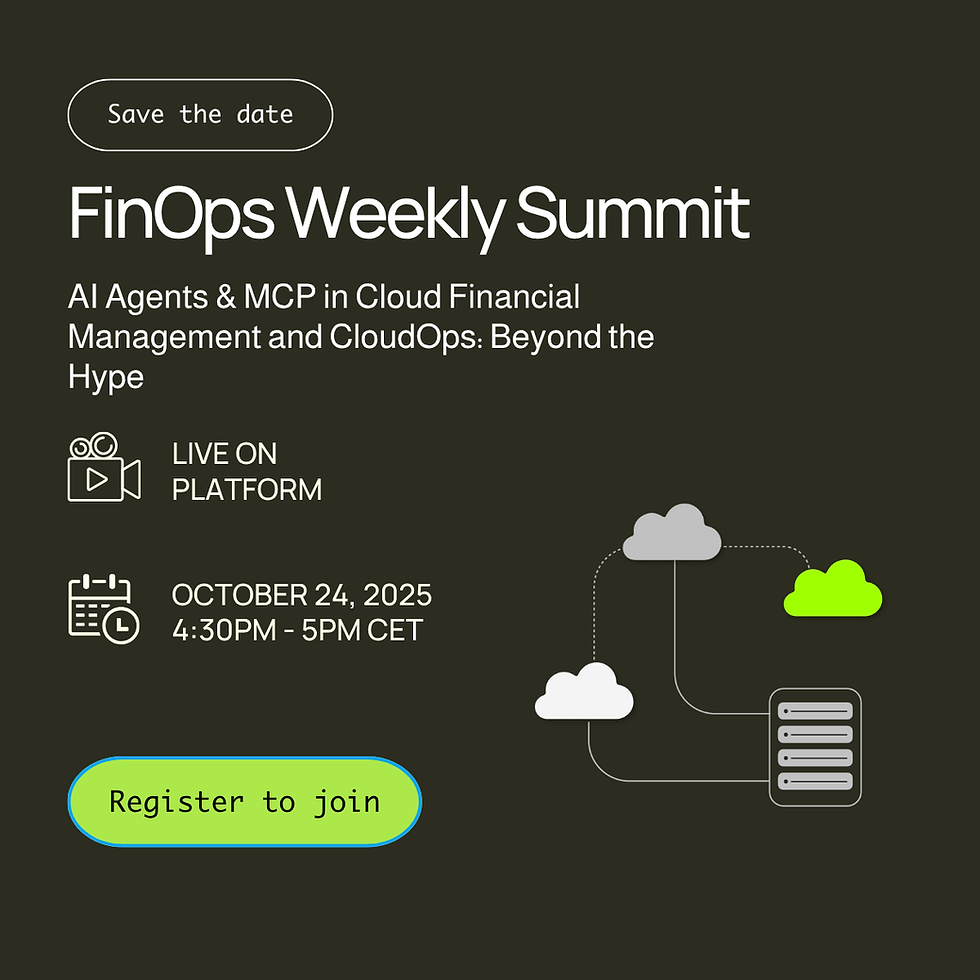Adopt optimized cloud management with OptimNow
- Jean Latiere
- Nov 13
- 3 min read
In a context of skyrocketing cloud spending and increasingly complex digital environments, cost control has become a major strategic challenge. Optimized cloud management is no longer simply about reducing bills. It is part of a comprehensive approach encompassing governance, operational efficiency, and sustainable innovation. This is where the FinOps discipline truly comes into its own, combining finance, technology, and corporate culture to generate a tangible return on investment.
Why adopt optimized cloud management?
Optimized cloud management aims to align cloud spending with business objectives, while ensuring infrastructure performance and flexibility. Without a structured framework, organizations face unexpected costs, underutilized resources, and limited visibility into their consumption.
The main issues are:
Cost control : avoid unnecessary expenses and optimize resources.
In this blog post, explore the synergy between cloud optimization and FinOps, uncovering strategies to enhance efficiency, reduce costs, and drive sustainable IT practices for businesses seeking to maximize their cloud operations.
Transparency : having accurate and accessible data for all stakeholders.
Collaboration : involving finance, engineering and purchasing in a common approach.
Agility : rapidly adapting resources to actual needs.
Sustainability : integrating responsible practices to reduce the carbon footprint.
For example, a company that doesn't monitor its cloud instances risks paying for unused or oversized servers. By applying FinOps principles, it can reduce its costs by an average of 20 to 30%, while simultaneously improving service quality.

The pillars of optimized cloud management
To succeed, optimized cloud management relies on three fundamental pillars, derived from FinOps best practices:
1. Visibility and measurement
The first step is to collect accurate data on cloud consumption. This includes:
Cost tracking by project, team or department.
Analysis of consumer trends.
The implementation of relevant KPIs, such as cost per active user, cost per workload, or resource utilization rate.
These indicators make it possible to identify potential savings and anticipate potential problems.
2. Continuous optimization
Cloud management doesn't stop at a one-off audit. It requires an iterative approach:
Adjust instance sizes according to actual needs.
Automate the shutdown of unused resources.
Negotiate contracts and reserve capacity in advance.
Leveraging artificial intelligence tools to predict peaks and adapt resources.
3. Collaborative culture
Success depends on close collaboration between the technical, financial, and purchasing teams. This involves:
Regular meetings to share data and decisions.
Shared responsibility for cloud budgets.
Training teams in FinOps best practices.
This approach promotes buy-in and collective effectiveness.
How to integrate FinOps into your cloud strategy?
The integration of FinOps into optimized cloud management follows a structured framework, inspired by international standards. Here are the key steps:
Initial assessment
Map current spending.
Identify the stakeholders.
Define the financial and operational objectives.
Implementation of tools
Choose appropriate monitoring and analysis solutions.
Automate data collection.
Configure custom alerts and reports.
Governance and processes
Establish clear rules for resource management.
Set up a FinOps committee bringing together finance, engineering and procurement.
Define regular review cycles.
Training and communication
Raising awareness among teams about the issues and best practices.
Sharing results and successes.
Encourage continuous improvement.
This pragmatic approach makes it possible to transform cloud management into a lever for sustainable performance.

The tangible benefits of optimized cloud management
Adopting optimized cloud management generates measurable and impactful results:
Cost reduction : up to 30% savings through resource optimization and negotiation.
Improved predictability : better controlled budgets and fewer surprises.
Time savings : automation of repetitive tasks and reduction of manual interventions.
Better performance : resources adapted to actual needs, avoiding overconsumption.
Sustainable commitment : reducing carbon footprint through responsible management.
For example, an organization that adopted a FinOps culture was able to reduce its AI costs by 25% by optimizing its GPU instances and automating the shutdown of test environments.
Towards optimized and sustainable cloud management with OptimNow
To support this transformation, it is essential to rely on experts and high-performance tools. Optimnow offers an innovative platform that integrates FinOps best practices, combining advanced analytics, automation, and artificial intelligence.
This solution allows you to:
Visualize cloud spending in real time.
Quickly identify anomalies and optimization opportunities.
Effective collaboration between finance, engineering and procurement.
Integrate sustainability criteria into resource management.
By adopting a pragmatic and data-driven approach, OptimNow helps organizations control their cloud costs while preparing for the future with innovative business models.
Adopting optimized cloud management is an essential strategic lever for any organization wishing to control its expenses, improve its performance, and commit to a sustainable approach. By leveraging FinOps principles and appropriate tools, it is possible to transform the complexity of the cloud into a clear and measurable competitive advantage.


.png)